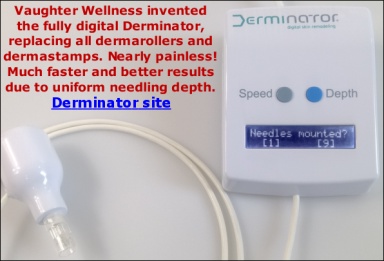>I would like to know if it is safe to use a dermaroller if you have had
>Botox or some kind of filler.
First four weeks,you should only use < 0.3 mm needles. Don't use long needles when fillers have been freshly injected, wait about four weeks before rolling over the areas with longer needles than 0.3 mm because the rolling might speed up the breakdown of the filler.
You can roll around it, just do not roll for four weeks directly over the areas that were injected with a filler.
Do not perform any kind of microneedling over the botoxed area for the first two weeks. It can take up to two weeks for Botox to maximally paralyze the muscle (by blocking the receptors on the muscle).
>If you have bottox on your forehead and coaptite filler (radiesse) in your cheeks, does rolling with dermaroller interfere and reduce their duration or is it safe?
No problem with dermarolling after Botox but do not roll for two weeks directly over the Botox area and for four weeks over the fillers area with needles longer than 0.3 mm.
Radiesse or other fillers are applied to the bottom of the dermis and the layer immediately below it (subcutis) and this is too deep for a dermaroller.
If you want to be absolutely sure, stop using needles longer than a 1.5 mm and do not deep single needle the cheeks, directly over where the filler is. The needles of a dermaroller never penetrate the skin to their full length so there should be no problem even with a 2 mm roller.
In the Botox area, you can use any size of needles and deep needling (after two weeks).
There were two studies done on whether laser therapy, radiofrequency or IPL negatively affect dermal fillers and they both found it did not have any negative effect on the fillers (in spite of the fact that radiofrequency penetrates really deep). At the moment I only found one study of those two:
Randomized Trial to Determine the Influence of Laser Therapy, Monopolar Radiofrequency Treatment, and Intense Pulsed Light Therapy Administered Immediately after Hyaluronic Acid Gel Implantation
BACKGROUND Hyaluronic acid-based dermal fillers, such as hyaluronic acid gel (Restylane, Q-Medical AB, Uppsala, Sweden), are widely used for tissue augmentation of the nasolabial folds. Additional dermatologic treatments using infrared light, radiofrequency (RF), and intense pulsed light (IPL) are also important tools for facial rejuvenation. This study was designed to evaluate whether these therapies could be safely administered immediately after hyaluronic acid gel treatment without compromising the effect of the dermal filler.
OBJECTIVE The objective of this study was to confirm or refute any possible subtractive effects of augmentation of the nasolabial folds when followed by 1,320-nm Nd:YAG laser, 1,450-nm diode laser, monopolar RF, and/or IPL treatments.
METHODS Thirty-six patients with prominent nasolabial folds were treated with hyaluronic acid gel implantation on one side of the face and hyaluronic acid gel followed by one of the nonablative laser/RF/IPL therapies on the contralateral side of the face.
RESULTS There were no statistically significant differences between wrinkle severity or global aesthetic scores for hyaluronic acid gel implantation alone and hyaluronic acid gel with laser/RF/IPL treatment at any time point. In a small sample, histologic changes were not apparent after laser/RF/IPL treatment.
CONCLUSIONS Based on this small pilot study, laser, RF, and IPL treatments can safely be administered immediately after hyaluronic acid gel implantation without reduction in overall clinical effect.
>And, do you know any "home made" method to fill the cheeks other than the expensive filler by the dermatologist?
No, there is unfortunately no DIY method. You can have it filled with you own fat in a surgery and supposedly, if well done, it lasts very long.





